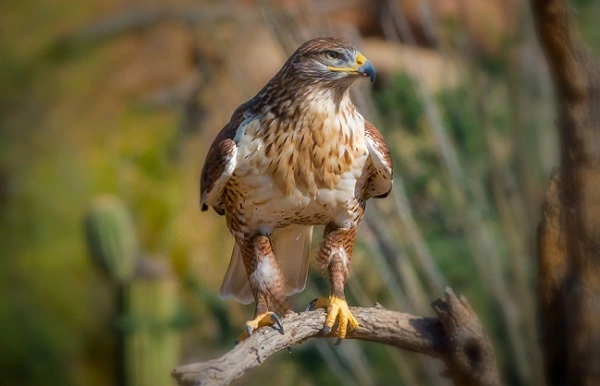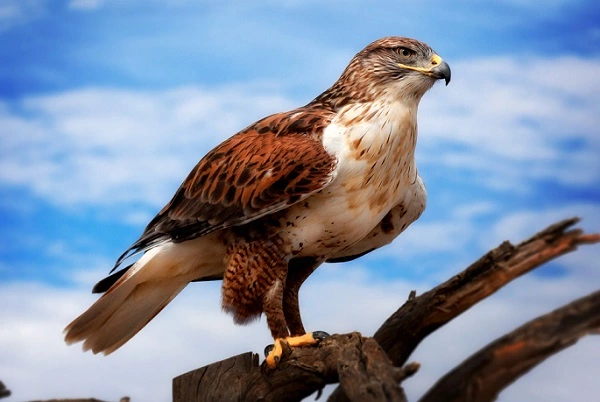The ferruginous hawk is one of the most fascinating raptors in North America. This large, dark raptor has a number of unique features that make it stand out from other hawks. In this blog post, we will discuss the ferruginous hawk’s ecology, distribution, and identification. We will also explore some of the myths and misconceptions about this incredible bird. Stay tuned to learn more about the ferruginous hawk!

Ferruginous Hawk Description
The Ferruginous Hawk is a large hawk of the Buteo genus. It ranges across North America, from Alaska and Canada to Mexico. The Ferruginous Hawk is one of the heaviest members of the Buteo genus, and its broad wings and powerful legs give it tremendous soaring capability. The Ferruginous Hawk preys mainly on rodents, such as ground squirrels and prairie dogs. In some areas, it will also take rabbits, reptiles, and birds. The Ferruginous Hawk nests on the ground, often in an area of short grass or sagebrush. The female Ferruginous Hawk lays 3-5 eggs, which hatch after about 30 days. The Ferruginous Hawk is protected under the Migratory Bird Treaty Act.
Ferruginous Hawk Habitat
Ferruginous Hawks are one of the larger hawk species, with wingspans that can reach up to six feet. They get their name from the rusty color of their feathers, which helps to camouflage them in their natural habitat of open grasslands and prairies. Ferruginous Hawks are fierce hunters, and they use their sharp talons to kill small mammals, reptiles, and birds. In addition to being skilled predators, Ferruginous Hawks are also excellent scavengers, and they often steal prey from other birds of prey. As development and agriculture have led to the loss of Ferruginous Hawk habitat, the population of these birds has declined sharply. As a result, Ferruginous Hawks are now considered a species of concern by many conservation organizations.
Ferruginous Hawk Diet
The Ferruginous Hawk is a large bird of prey that is native to North America. These hawks are most commonly found in the western United States, where they inhabit open grasslands and prairies. Ferruginous Hawks are opportunistic hunters and will feed on a variety of small animals, including rodents, reptiles, and birds. These hawks will also eat carrion if it is available. Ferruginous Hawks typically hunt from a perch, using their keen eyesight to spot potential prey. Once they have spotted their quarry, they will swoop down and capture it with their powerful talons. Ferruginous Hawks generally mate for life and will build large nests made of sticks and grasses. These nests are typically located in trees or on cliffs. Ferruginous Hawks usually lay two or three eggs at a time, which hatch after about a month. The young hawks will stay in the nest for several weeks before learning to fly and fend for themselves. Ferruginous Hawks typically live for about fifteen years in the wild.

Ferruginous Hawk Size
The Ferruginous Hawk is a large hawk with a body length of 19 to 21 inches and a wingspan of 52 to 58 inches. It has a rusty-red body with pale underparts, and it gets its name from the rusty-red patches on its wings. The Ferruginous Hawk is found in open habitats such as grasslands, prairies, and deserts. It nests in trees or on cliffs, and it typically lays two to four eggs. Ferruginous Hawks are predators, and they hunt small mammals such as rabbits and rodents. They also eat reptiles, birds, and insects. Ferruginous Hawks are confined to North America, and they are found in western Canada, the western United States, and northern Mexico. The Ferruginous Hawk is hunted by humans and is also threatened by habitat loss.
Ferruginous Hawk Lifespan
Ferruginous Hawks are a species of hawk that is native to North America. Ferruginous Hawks have a lifespan of approximately 20 years in the wild. Ferruginous Hawks typically mate for life and will often return to the same nesting site each year. Ferruginous Hawks are predators and will hunt a variety of small mammals and birds. Ferruginous Hawks are also known to eat reptiles, amphibians, and invertebrates. Ferruginous Hawks typically nest in trees or on cliffs. Ferruginous Hawks are protected under the Migratory Bird Treaty Act. Ferruginous Hawks are considered to be a threatened species due to habitat loss and human disturbance.
Ferruginous Hawk Behavior
Ferruginous Hawks are large, broad-winged hawks that are found in open habitats across North America. Ferruginous Hawks hunt from perches or by circling low over the ground, looking for prey such as rabbits, rodents, and snakes. They will also eat carrion and sometimes small birds. Ferruginous Hawks are important predators in open ecosystems such as grasslands and prairies. Ferruginous Hawks mate for life and build large nests made of sticks and twigs. The female lays 2-4 eggs per clutch, and the young hawks fledge after about 6 weeks. Ferruginous Hawks are named for their rusty-colored plumage, which is most common in adults. Immature Ferruginous Hawks are generally pale with dark streaks on their breast and back. Ferruginous Hawks are protected under the Migratory Bird Treaty Act.
Ferruginous Hawk Speed
Ferruginous Hawks are fast flyers, reaching speeds of up to 55 miles per hour when diving. They typically fly at a slower pace, around 30 miles per hour, when hunting or cruising. Ferruginous Hawks are powerful flyers, using their broad wings to soar and glide for long periods of time with little effort. Their flight patterns are often erratic, making them difficult to follow with the naked eye. Ferruginous Hawks are one of the fastest flying birds of prey, and their speed and agility make them adept hunters.
Ferruginous Hawk Hunting
Ferruginous hawks are fierce predators that hunt a variety of prey, including rabbits, snakes, and rodents. These hawks use their powerful talons to kill their prey, and they often hunt in open areas where they can spot their prey from a distance. Ferruginous hawks typically hunt alone, but sometimes they will team up with other Hawks to take down larger prey. When hunting in pairs, Ferruginous hawks will often cooperative in order to corner and capture their prey. These hawks are excellent hunters and they play an important role in keeping populations of rabbits, snakes, and rodents in check. Ferruginous hawks are an important part of the ecosystem and they provide a valuable service to humans by helping to control populations of pests.
Conclusion
Ferruginous Hawks are large raptors that can be found in open habitats across North America. They are easily identified by their rusty-colored plumage and white underparts. These hawks feed primarily on small mammals, but will also take birds, reptiles, and amphibians. In the fall and winter months they often congregate in groups known as kettles to hunt large prey items. Ferruginous Hawks have been listed as a species of Least Concern by the IUCN due to their widespread distribution and healthy population numbers.
Frequently Asked Question

